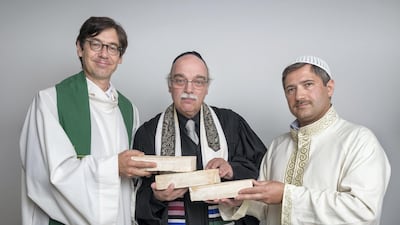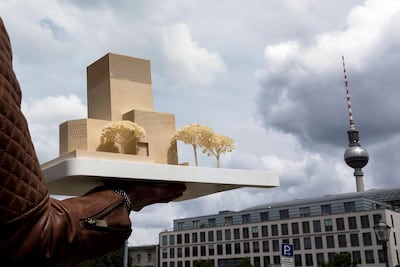Under the 2.3 million red bricks arching over a new building in Berlin it is hoped that the seeds of peace can grow between the three Abrahamic religions.
When the cornerstone is laid at the House of One building this spring it will mark an increasingly global desire for togetherness among Muslims, Jews and Christians.
A decade in the making, the project puts all three religions under a single roof, a concept growing around the world with the Abrahamic House in Abu Dhabi scheduled for completion next year and similar projects in the Central African Republic and Georgia in eastern Europe.

In interviews with The National, an imam, rabbi and priest said that the House of One could mark greater understanding between the monotheist beliefs.
“The Muslim community is tired of hate, violence and terror being spread to the world in the name of Islam,” said Imam Kadir Sanci. “Now they see that Muslims – together with Jews and Christians – are finally working effectively for peace.
"Many Muslims are happy that the House of One can be the voice of peace that can drown out the voice of violence.”
His words were echoed by Rabbi Andreas Nachama. “The idea to have Jews, Muslims and Christians under one roof is attractive to people because it's a step towards peace between the religions,” he said.
For more than 50 years, a parking lot in what was East Berlin stood largely empty, with memories of the great church of St Peter, demolished by the communists, largely forgotten in the Petriplatz area.
But in 2009, at the height of the conflicts in Iraq and Afghanistan, a group of religious thinkers decided that a route out of violence would be greater understanding by building a church, a synagogue and a mosque all housed within a central building.
“The Protestant community decided that we wanted not to rebuild a church, but a sacred building to mirror the religious situation in our city,” said Protestant theologian Roland Stolte, one of the founders.
“We wanted to step back and give room for other religions, that was the main premise, for Jews and Muslims to join us in one sacred building.”

The Protestant theologian said the concept accepted that there was “no exclusivity of truth in other religions” but that the idea of House of One was to “look for hints of truth in other religions or in other worldviews”.
The idea found global appeal. Donations totalling almost €9 million ($10.7m) poured in from 60 countries, including Egypt, Jordan and the UAE, as well as €30m from the German government.
Respect for each religion’s individual services and practices will be strictly observed in the 46-metre tall building, which is separated into four distinct parts. It will contain three religious structures, each able to accommodate about 100 worshippers, and a central hall in which everyone is welcome, from atheists to tourists and people of all religions.
The project has close ties with the Abrahamic Family House in Abu Dhabi that will be completed next year. "We discussed it with people from the UAE embassy in Berlin and they have the same ideas, system and structure," Mr Stolte said. "The same hope too for more harmony between religions."
From a theological perspective, each theology accepts there should be no objection to the concept. "It is in the tradition of our honourable Prophet," Imam rSanci said. "For us, every step we take must be in accordance with the Quran and the Sunnah."
Father Gregor Hohberg, 53, a Lutheran pastor, said the philosophy was contained in the teachings of Jesus.
“This goes hand in hand with the sharing and relinquishing of historically grown power, influence and privileges – entirely in the spirit of Jesus,” he said.
“There are theological challenges and questions but no religion can come into the House of One with a final theology or an absolute claim of truth.”
Worshippers were attracted to his congregation because of the project.
“We are not trying to create a mixed religion, but rather to live and celebrate diversity and the richness of differences.”
Imam Sanci accepted there would be some concerns within the Muslim community, among people who do “not know their own religion and its history sufficiently”.
The idea of “sharing an umbrella” with Christians and Muslims came in the knowledge “that Abraham is our common father in belief and that we have the same God … is progress”, Rabbi Nachama said.
Indeed, this symbolism of unity, forgiveness and understanding has greater meaning among the Jews in Germany where its people were the victims of the Holocaust. Today, their number is just 200,000, where once there were an estimated 318,000 Jews and many more from a Jewish background before the Nazis came to power.

But Rabbi Nachama, whose father survived the Auschwitz and Sachsenhausen concentration camps and whose mother was sheltered by a non-Jewish German family, believes the new building can go some way to resolving conflict. “We can have greater understanding that while each has his own tradition we share the Earth and we share the one God.”
Imam Sanci is hopeful that the more people from different religions learn about each other, the greater the chances of peace.
“From the first minute of my involvement in the House of One, I was convinced that we are making an important contribution – albeit a modest one – to world peace. When people have conversations at eye level they are more likely to find reasons to be friendly with each other,” he said. “People who refuse to get to know their counterparts are more prone to hostility and violence.”



